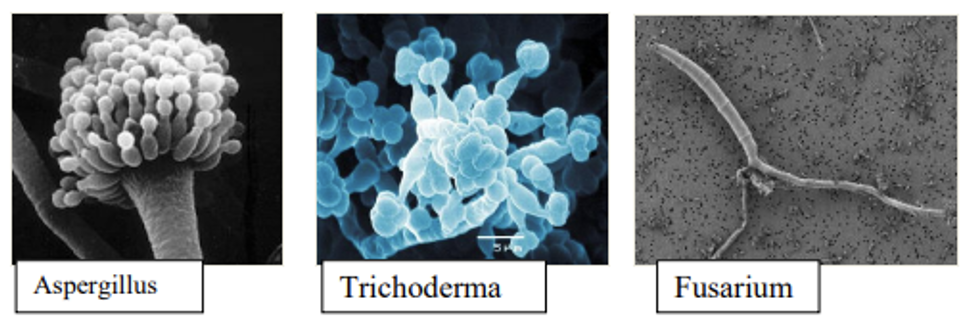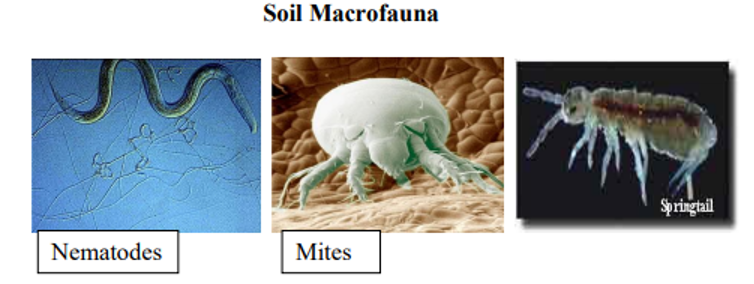🐜 Soil Biology
Soil micro and macro flora and fauna
- Soil biology is the study of microbial and faunal activity and ecology in soil.
- These organisms include earthworms, nematodes, protozoa, fungi and bacteria.
- Soil biology plays a vital role in determining many soil characteristics yet, being a relatively new science, much remains unknown about soil biology and about how the nature of soil is affected.
Soil organisms
- Soil organisms are involved in nearly every aspect of soil quality
- Role of soil organisms are:
- Soil N utilization by plants
- Dead organic matters decomposed
- Nutrient transformation
- Physical (structure/aggregation) and chemical properties of soil.
- The CO2 content
- Soil formation

Microorganisms
- Microorganisms are also classified based on their ability to grow in the presence or absence of molecular oxygen as aerobes and anaerobes.
- Based on temperature
- Psychrophiles
- Mesophiles
- Thermophiles
- Microorganisms are also classified based on morphology, shape, size, biochemical transformations they carryout.
- Soil organism are classified broadly soil flora and soil fauna.
- These again may be subdivided into micro and macro.
- Micro flora again is classified into Bacteria, Actinomycetes, Fungi and Algae.
Bacteria

- Single celled.
- The cells may be rod shaped or spherical.
- The rods may be about 1 µm wide and up to 3 µm long and about 2 µm in diameter.
- Bacteria are the most abundant group of microorganism in the soil.
- Their population in the soil is not uniform.

Classification of bacteria
- Based on O2 requirement: Aerobic and anaerobic
- Based on temperature
- Facultative
- Psychrophiles
- Mesophiles
- Theromophile
- Based on their food preparation:
- Autotroph
- Heterotroph
- Chemoautotroph
- Obligate chemoautotrophs: Prefer specific substrates
- Nitrobacter – Nitrite as substrate
- Nitrosomonas – Ammonia as substrate
- Thiobacillus - Converts sulphur compounds to SO4
- Ferrobacillus – Converts ferrous to ferric
- Based on symbiotic relationship:
- Symbiotic N fixers:
- Associated with a host plant.
- Both the host and the bacteria get the benefit.
- Fix atmospheric N.
- Non symbiotic N fixers:
- Bacteria present without the association of a plant.
- But fix atmospheric N.
- Symbiotic N fixers:
- Symbiotic, non-symbiotic and cellulose decomposers come under Heterotrophs
- Nitrifiers, denitrifiers Nitrate formers and sulphur oxidizers are autotrophs.
Role of Bacteria
- Bacteria carryout the decomposition of organic matter and synthesis of humus
- Enzymatic transformations are carried out by bacteria
- Bacteria oxidize or reduce many chemical reactions such as N fixation, sulphur oxidation nitrification etc.
👉🏻 Conditions affecting the growth of bacteria:
- Oxygen
- Moisture
- Temperature
- Organic matter
- Exch. Ca and pH
- High Ca concentration and pH 6.0-8.0 optimum.
- Some bacteria function at pH < 3
- Exchangeable Ca is more important than pH. The bacterial population may be 10-8 -10-9/gram.
- The biomass may vary from 450-4500 kg/ha.
Actinomycetes
- Unicellular like bacteria. Have same size as bacteria.
- Filamentous and profusely branched.
- Mycelial threads are smaller than those of fungi.
- No nuclear membrane as in bacteria.
- Also called as filamentous.
- Sensitive to acid soils.
Potato scaba disease due to actinomycetes can be controlledby lowering the soil pHby applying Sulphur.- Heterotrophic optimum temperature 25-30°C, pH 6.5 – 8.0.
- Actionomycetes are important for organic matter decomposition.
- Chitin and phospholipids are reduced to simple compounds.
- The aroma of freshly ploughed land at certain times of the year is probably
due to actinomycetesas well as certain molds. - Actinomycete population in soil exceed all other organisms except bacteria.
- Their proportion increases with soil depth. Their population and biomass are almost equal to that of bacteria.
Fungi

- Soil fungi may be parasitic or saprophytic.
- They possess filamentous mycelium composed of individual hyphae which are 5-20 µm in diameter and several centimeters in length.
- Most fungi are heterotrophic and hence they depend on the organic matter content of the soil.
- They are dominant in acid soils some can tolerate a pH upto 9.0.
- Fungi are strictly aerobic.
- Fungi are classified into Phycomycetes, Ascomycets, Basidiomycetes and fungi imperfecti.
- Fungi may also may be classificied as: Molds, Yeast, Mushrooms

Molds
- Molds are filamentous microscopic molds develop vigorously in all types of soils
- In acid forest soils - decomposing organic matter.
- The common genera - mucor, Fusarium and Aspergillus.
- Their average population - 10-200 billion / m2.
- In humus formation and aggregate stabilization molds are more important than bacteria.
- They continue to decompose complex organic substances after bacteria and actinomycetes have stopped function.
Yeast
- Yeast is a group of fungi which exist as an unicellular organism.
- Reproduce by fission or budding.
- Used as food supplement and also for the production of alcoholic beverages.
- Yeast is not common in soils.
- They produce several plant diseases.
Mushroom
- Mushrooms are present in forests and grasslands where there are ample moisture and organic residues.
- Some mushrooms are edible.
- Mushrooms are also not common in cultivated soils.
- Their fruiting body is above the ground.
Algae
- Algae are filamentous u-10 µm in diameter. Population in soil around 1-10 billion / m2.
- Their mass in soil may be 50-600 kg/ha of furrow slice.
- Algae are photo autotrophs
- They are divided into 4 general groups. Blue green, Green, yellow green and diatoms
- Blue green algae are numerous in rice soils
- Blue green algae growing within the leaves of aquatic Fern. Azolla can also fix atmospheric N.
Soil Fauna

Macro Fauna- Earthworm
- About 1800 species of earthworms are known.
- There are 293 species in the genus Pheretima. The common earthworms found in India are Pheretima posthuma, P. elongater, Lampita mautritii etc.
- Their population may vary from 1,25,000 to 1000000/ha.
- They are active in monsoon season. The worms prefer organic matter as their food.
- They also consume larvae of small animals and bacteria mixed with earth.
- They ingest soil in large quantities which pass through the alimentary canal which has many grinder gizzard
- The ingested soil and organic matter are ejected in the form of castings.
- They make crores of burrows which make the soil porous.
- Earth worms prefer warm (21°C) well aerated soils. The casts have low C:N ratio.
- The burrows left in the soil increase aeration and drainage. They increase the size and stability of soil aggregates.
- The factors influencing the earth worm population and activity in the soil are availability of organic matter, soil pH, temperature and soil moisture.
- The biomass or live weight of earth worm may range from 110-1100 kg/ha.
Ants
- They have local effects. Some have the ability to break down woody materials.
- Some ants produce mounds and some have underground nests.
- There is considerable turnover of the soil due to these.
- The ants and termites can modify soil structure and till the soil.
Nematodes

- Commonly called as thread worms or eelworms. Present in almost all soils.
- They are microscopic most of the nematodes are Saprophytes
- They may feed on other nematodes, bacteria, algae and protozoa.
- The genus Heterodera can infest the roots of all plants.
- Heavy infestation may cause severe damage in vegetable crops.
Micro Fauna - Protozoa

- Single celled, larger than bacteria and are more complex.
- Soil protozoa may be amoeba, celiates and flagellates.
- Soils have more than 250 species. Live weight in soil ranges from 15-175 kg/ha.
- They cause a number of serious diseases in animals and plants.
- They thrive well in moist and well drained soils and on the surface.
- They are not abundant in soils to play a major role in the organic matter decomposition and nutrient release.
Rotifers
- About 100 species have been studied. They thrive under moist and swampy lands.
- Activities are confined to peat bogs and wet areas of mineral soils. Roots of higher plants
- Since the roots grow and die in the soil they supply food and energy for the soil microflora and fauna.
- They physically modify the soil as they push through cracks and make new openings.
- By removing moisture from the soil the plant roots create physical stress that stimulates soil aggregation.
- Plant roots exudates several chemicals which stabilize the soil structure.
- They decay and supply the material for the synthesis of humus.
- Roots constitute about 15-40% that of above ground crop.
Mycorrhizae
🚩 This will be covered in mannures lesson.
- Soil biology is the study of microbial and faunal activity and ecology in soil.
- These organisms include earthworms, nematodes, protozoa, fungi and bacteria.
- Soil biology plays a vital role in determining many soil characteristics yet, being a relatively new science, much remains unknown about soil biology and about how the nature of soil is affected.
Soil organisms
- Soil organisms are involved in nearly every aspect of soil quality
- Role of soil organisms are:
- Soil N utilization by plants
- Dead organic matters decomposed
- Nutrient transformation
- Physical (structure/aggregation) and chemical properties of soil.
- The CO2 content
- Soil formation

Microorganisms
- Microorganisms are also classified based on their ability to grow in the presence or absence of molecular oxygen as aerobes and …
Become Successful With AgriDots
Learn the essential skills for getting a seat in the Exam with
🦄 You are a pro member!
Only use this page if purchasing a gift or enterprise account
Plan
Rs
- Unlimited access to PRO courses
- Quizzes with hand-picked meme prizes
- Invite to private Discord chat
- Free Sticker emailed
Lifetime
Rs
1,499
once
- All PRO-tier benefits
- Single payment, lifetime access
- 4,200 bonus xp points
- Next Level
T-shirt shipped worldwide

Yo! You just found a 20% discount using 👉 EASTEREGG

High-quality fitted cotton shirt produced by Next Level Apparel